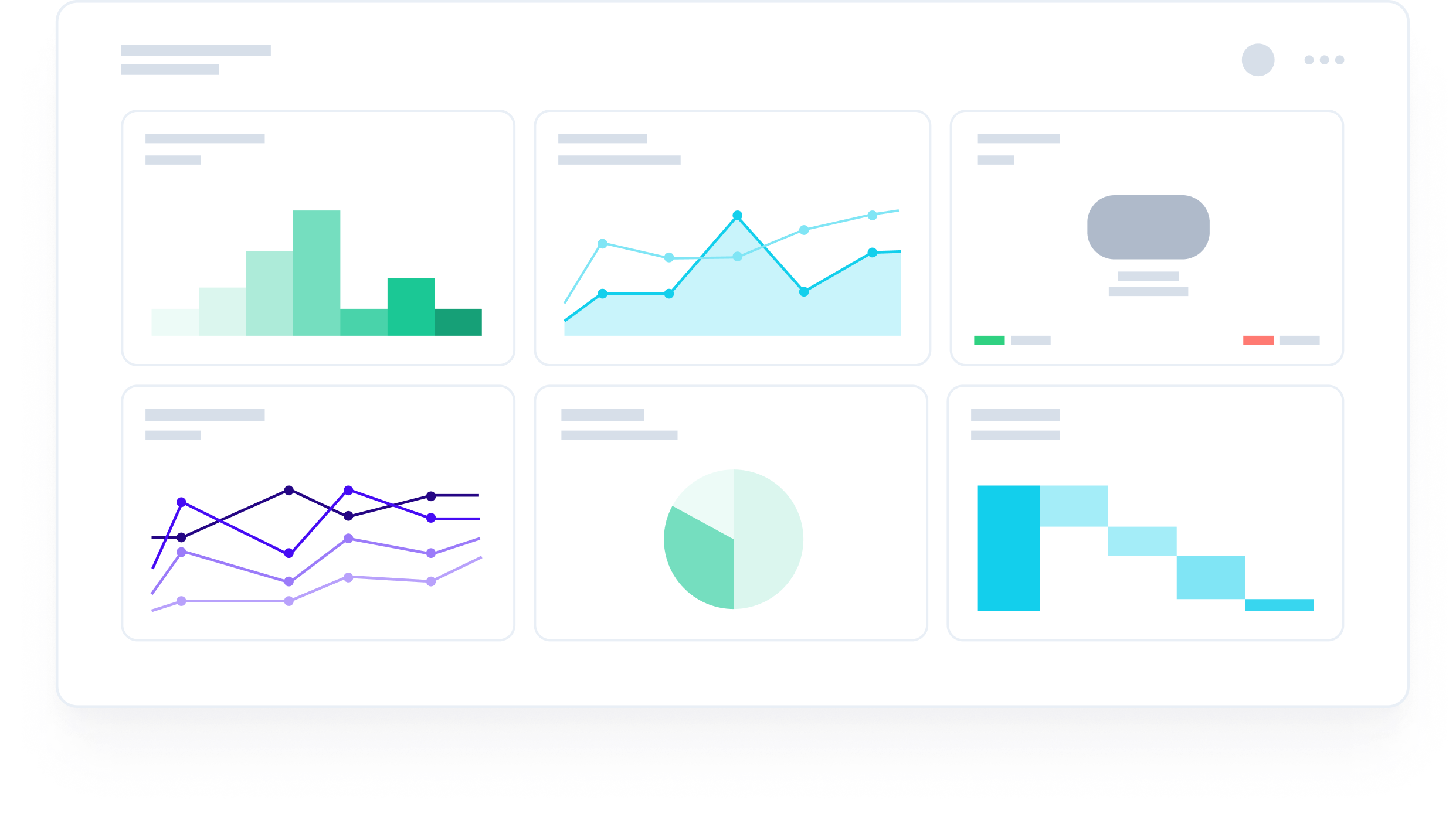CMO Dashboard: Examples, Templates, and KPIs

Co-Founder & CTO
Chief Marketing Officer (CMO) dashboards empower marketing leaders with the most important data points regarding their marketing programs.
Marketers leverage data daily to make decisions, optimize campaigns, and engage their audiences, but each marketing channel has its own data points. The sheer quantity of data available to teams can be overwhelming. The CMO dashboard becomes a necessary tool to help CMOs distill information and make data-backed decisions.
Learn how to build a CMO dashboard that can help your CMO make strategic decisions and align marketing strategies with business objectives.
Understanding the CMO Dashboard
A CMO Dashboard is a digital command center that consolidates key performance indicators (KPIs) and marketing metrics into a single, visually compelling interface.
Unlike other dashboards, the CMO Dashboard tailors its focus specifically to marketing performance. In the CMO dashboard example below, you’ll notice the focus on campaign effectiveness, website performance, and overall marketing ROI.
These dashboards help CMOs measure marketing performance against business goals, interpret large data sets, and focus their attention on the metrics that matter most.
In fact, 87% of marketers consider data their company’s most underutilized asset. A CMO dashboard is an incredible opportunity to bring data to the forefront of marketing decisions.
6 Key Components of an Effective CMO Dashboard
An effective CMO marketing Dashboard isn't about bombarding them with numbers; it's about presenting a curated selection of essential KPIs and metrics. While each marketing program will place emphasis on slightly different metrics, the dashboards often include the following.
1. ROI
By reviewing campaign costs and average sales price, marketing leaders can get a better understanding of the ROI of their marketing efforts and focus their energy on the activities that make the biggest impact. This helps teams improve marketing efficiencies, better leverage marketing budget, and secure additional resources for the initiatives that are bringing in results.
Average Sales Price

2. Website Acquisition
The website is often one of the first touchpoints a potential customer has with your brand, making it an incredibly important tool. Metrics such as website visitors can help CMOs determine whether top-of-funnel marketing tactics are working.
At the same time, website visitor conversion rate can help CMOs identify whether the on-page experience is pushing visitors to convert. The average conversion rate for B2B websites is 2.23% and while that number is seemingly small, it can amount to significant revenue if enough traffic is being directed to the site.
3. Campaign Attribution
B2B SaaS marketing teams are running multiple marketing campaigns each year with a variety of messaging, resource allocation, and objectives. To learn which campaigns are influencing pipeline and bookings, CMOs can review campaign attribution. This can help leaders identify which campaigns are driving the most pipeline and closed-won opportunities and which touchpoints within the campaigns were the most effective.
Campaign Attribution to Bookings

4. Lead Generation
Lead generation is essential to any B2B CMO dashboard, and helps leaders understand whether acquisition efforts are effectively getting new leads into the funnel. If lead generation efforts are low, it can spell trouble for the rest of the marketing funnel and the sales pipeline. Catching lead generation trends early can help CMOs make adjustments and optimize marketing tactics before it affects the rest of the funnel.
Lead Funnel example

5. Lead Conversion
Understanding how many leads are entering the funnel is important but so is knowing how those leads are converting at each stage of the funnel. By reviewing conversion across the funnel from Lead to MQL and MQL to SAL, marketing leaders can learn whether or not optimizations need to be made in their marketing efforts.
MQL to SAL Conversion Rate

For example, if barely any leads are converting into MQLs, it’s possible that the qualifications are too strict or the wrong audience is being targeted. If there are a lot of MQLs but those MQLs are making it to the SAL stage, it’s possible that the qualifications need to be more stringent.
6. ABM Funnel
For marketing programs that focus a lot of energy on account-based marketing (ABM), the ABM funnel can help track account progression through marketing and sales funnel stages, identify bottlenecks within the funnel, and align sales and marketing efforts across these accounts.

Building Your CMO Dashboard
Now that you know what key metrics the CMO dashboard should include, let’s discuss how to go about building your CMO dashboard.
1. Consider what features are most important
CMO dashboards can offer a variety of features, such as ease-of-use, real-time data, and customization options. Consider what is most important to you and to marketing leadership in a dashboard. This will help you narrow down what marketing dashboard tool you choose.
- Real-time data visualization: CMOs are often making decisions that can influence the overall success of the business. They need access to data in real-time to ensure they’re armed with the most accurate information to make the best decisions. This also eliminates any manual effort to update the dashboard.
- Ease-of-use: If it isn’t easy to use, your CMO will be asking the RevOps or data analytics team to pull the data points they need. Whatever platform you choose, needs to be something that they can easily access, update, and customize.
- Customization: Each company and marketing department has goals specific to their initiatives. Customization can help address some of the one-off marketing metrics specific to your company’s goals. But, don’t trade customization for ease-of-use. Highly-customized dashboards may need full-time hires to maintain.
- Implementation: Many solutions can take weeks, even months, to integrate your company’s data. As you explore the right revenue analytics platform for your company, consider the implementation time. Other companies offer pre-built CMO dashboard templates to make it easy to get up and running, allowing you to access insights almost instantaneously.
- One source of truth: Look for a solution that is able to integrate all of your marketing data in one place. If your CMO has to go into multiple platforms to access the data they need, then we’ve lost the ease-of-use. One source for all marketing data enables your CMO to look at the data much more holistically and see where there are opportunities for improvement.
2. Select the Best CMO Dashboard Tool
With your ideal features in mind, take a look at some of the top marketing dashboard tools to help you narrow down what you need.
- Sightfull offers real-time data monitoring, powerful visualizations, and out-of-the-box metrics, making it a great fit for both growing startups and SaaS enterprise organizations.
- Looker Studio is a user-friendly tool for creating data visualizations and offers easy integrations with Google products. However, it lacks the complexity of advanced data modeling.
- Qlik is a cloud analytics platform offering self-serve visualization tools and interactive dashboards. While Qlik makes it easy to collaborate and share data insights among your team, it struggles to quickly process large quantities of data and may be too expensive for large teams as it is priced per user.
- Tableau is best suited for enterprise organizations because of its ability to process large quantities of data and its higher cost compared to other Salesforce reporting tools. While Tableau is highly customizable, all reports must be built from the ground up, requiring users with more technical expertise.
3. Choose Your Key KPIs or Leverage CMO Dashboard Templates
With your ideal tool chosen, you can now integrate your data and select the KPIs you’d like to build into your dashboard. Some of the tools, such as Sightfull, offer ready-to-use templates to help you analyze your data and seamlessly build dashboards.
Designed for B2B SaaS businesses, here are a few of the readily available templates for marketing teams:
- Website acquisition template: Track website visitors, traffic sources, and website conversions.
- Campaign attribution template: Identify which campaigns are generating the most pipeline and closed won opportunities.
- Campaign cost template: Analyze marketing spend over time and across campaign types.
Lead generation template: Learn how leads are trending over time and which sources, segments or regions are generating the most leads. - ABM funnel template: Track account progression and identify bottlenecks throughout each stage of the funnel.
Access immediate insights

4. Analyze and iterate
Once you’ve chosen the KPIs or templates you’d like to include within your dashboard, it’s time to track and analyze those metrics. Share the dashboard with your CMO, marketing leadership, and larger team. Know that getting the right mix of metrics will take time, so iterate and adjust as new goals are set or priorities are adjusted.
Best Practices for CMO Dashboards
The dashboard is only helpful if the CMO and larger marketing team leverage it, so here are a few best practices to help the team incorporate it into their daily workflow.
- Making it a daily habit: Encourage your marketing team to incorporate the dashboard review into their daily routine. A few minutes spent analyzing key metrics can spark valuable discussions and identify areas needing immediate attention.
- Focusing on data in team meetings: Dedicate a portion of your weekly marketing team meetings to discussing insights gleaned from the dashboard. This fosters collaboration, shared accountability, and data-driven decision-making as a team.
- Driving actionable insights: Use dashboard insights to prompt actionable marketing adjustments and track the impact of those changes on future metrics.
The Future of CMO Dashboards
The world of data analytics is constantly evolving. Emerging trends like artificial intelligence (AI) and machine learning (ML) will further enhance CMO Dashboards. Imagine AI-powered dashboards that anticipate trends, predict outcomes, and recommend data-driven marketing strategies. As technology advances, CMO Dashboards will become even more sophisticated, empowering marketing leaders to navigate the ever-changing marketing landscape with confidence.

Sightfull leverages AI to help users answer data-related questions on their analytics and reporting. Check out Sightfull AI for more information.
Ready to build your CMO Dashboard?
Schedule a demo to see it in action!
Transform your ABM Strategy!
Make informed decisions on which campaigns work best for different types of accounts, driving exceptional results.